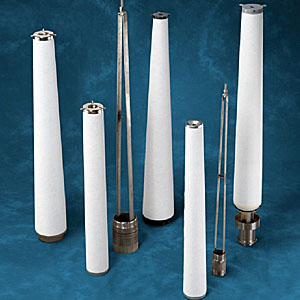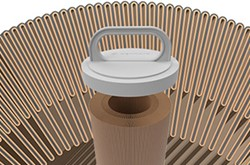- Home
- Technologies
- Apex
Pentair Apex Element is designed to maintain consistent annular velocities throughout its height. This is achieved by gradually widening the outer annular space from bottom to top, aligning with the gas flow as it exits the element. The Apex element technology was integrated into UltiSep, further enhancing separator performance with efficiencies exceeding 99.97%. APEX+ represents the latest advancement in optimizing these separation technologies.

Benefits
- Captures sub-micron aerosols
- Coalesces aerosols into larger liquid droplets
- Efficiently removes captured liquids from gas streams
-
FUNCTIONAL DESCRIPTION
-
Pentair Apex Element is tailored to ensure uniform annular velocities across its height. This is achieved by tapering the element gently, allowing the outer annular space to widen progressively from bottom to top, matching the flow of external fluid as it exits the element. The cylindrical elements require less spacing due to high fluid velocities at the circumference, allowing smaller vessel sizes and reduced capital costs.
Pentair Oil and Gas Separations designs and manufactures advanced separation products and systems for capturing particulate, liquid, and soluble contaminants from both liquid and gas streams. Originally developed over twenty-five years ago, the UltiSep Separator technology addressed shortcomings in traditional gas-liquid separators by significantly improving liquid and aerosol removal from gas streams.
-
APPLICATION AREAS
-
- Gas/Liquid Aerosol Removal from Gas StreamsLiquid/Liquid Fluid
- Quality Management of Hydrocarbon Systems
RELATED APPLICATIONS
The key aspects of an alkylation unit pertain to the amount of acid that needs to be made-up on a continuing basis. This cost becomes even more critical if the plant has no onsite acid regeneration, or the acid consumption exceeds the acid regeneration capacity.
BTX (BENZENE, TOLUENE AND XYLENE)
Purify benzene, toluene, and xylene (BTX) from refinery or petrochemical aromatics streams such as catalytic reformate or pyrolysis gasoline. This liquid-liquid extraction processes offers lower capital and operating costs, simplicity of operation, range of feedstock, and solvent performance.
Reactor products can contain gelatinous, deformable solids form in coating formulation. Batch Process: Limited reactor turn-over (constrained through-put) due to long filtration process. Reduce operating costs and batch cycle time, double capacity and increase online life.
Silicones are inert, synthetic compounds with a variety of forms and uses. Typically heat-resistant and rubber-like, they are used in sealants, adhesives, lubricants, medical applications, cookware, and insulation.
Proper fluid and proppant placement are critical to a successful propped fracture stimulation treatment.
Glycol dehydration is a liquid desiccant system for the removal of water from natural gas and natural gas liquids (NGL).
Natural gas gathering systems deliver large volumes of gas via pipeline to the central inlet of the gas processing facility. Removal of solid contaminants and free liquids present in the inlet gas is critical to the downstream process.
There are two basic steps to the treatment of natural gas liquids in the natural gas stream. First, the liquids must be extracted from the natural gas. Second, these NGLs must be separated themselves.
Until recently, the Liquefied Natural Gas (LNG) market was a relatively small part of the gas processing world. The market has experienced a transformation fueled by the discovery of vast reserves in North America, Asia’s robust economic growth, larger populations, and the demand for cleaner energy.
There are a number of factors that affect the capacity and operation of a typical amine system. Solid or liquid contaminants in the system may cause foaming. The presence of foaming is typically addressed by the addition of expensive antifoam chemicals and/or by reducing the operating capacity of the amine system.
The key aspects of a caustic treating system pertain to the degree of contact between the caustic and hydrocarbon to facilitate the mass transfer.
Eliminate hydrocarbons in Quench Water system, minimize fouling, provide greater system reliability, lower maintenance, lower energy costs.
Product custody transfer involves a number of processes, all of which are intended to meet transfer specifications in terms of water, particulate and metals.
Fuel Gas Streams are frequently contaminated with liquid aerosols. The liquid exists as a stable and persistent “smoke” in the gas stream.
The key to optimizing a hydroprocessing unit is to maximize the life of the catalyst bed and increase energy efficiency of the furnaces.
Many lube oil recovery processes create aqueous and hydrocarbon emulsions that are difficult to separate by means of conventional liquid/liquid separations technology.
Hydrocarbons in the sour water system are typically present on a continuous basis at up to 10,000 ppm and during upsets to levels greater than 50,000 ppm.


















